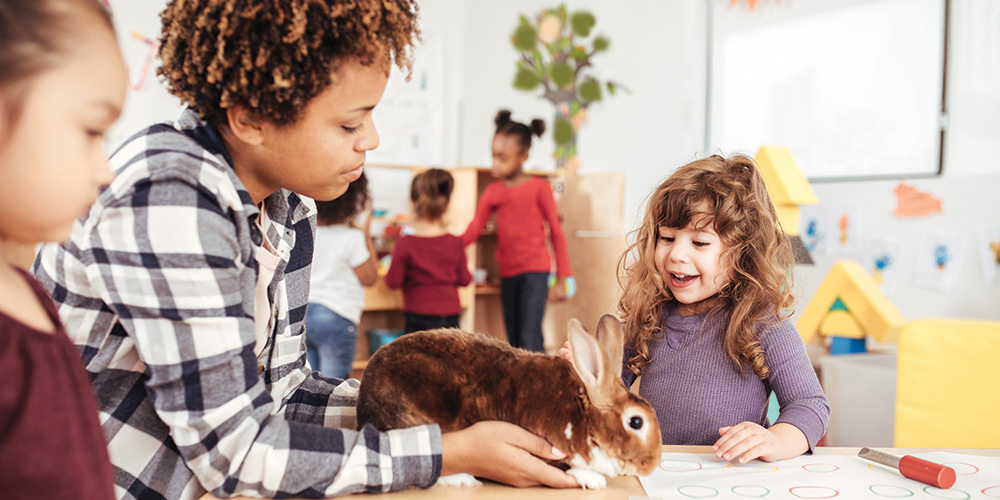Animals in the classroom. For some teachers, this phrase conjures images of happy students picking up the pet, taking turns caring for it, and uniting around a class mascot. For other teachers, all they can think of when it comes to classroom pets is the smell, the cleanup, the cost, the lost classroom space, the potential for distraction, and did we mention the smell?
According to Ty Cook, a seventh-grade life science teacher who’s had numerous pets in his class, “Classroom pets add so many positives to a classroom community and culture…[but they] are certainly a commitment and teachers need to thoughtfully consider the responsibility they are taking on before welcoming one into their classroom.” In this article, we’ll discuss the pros and cons of having animals in the classroom, as well as best practices and classroom activities for if you decide to get one.
Animals in the Classroom: The Pros
Drs. Robin R. Ganzert and Amy McCullough did an extensive study on animals in the classroom. They found that animals can have enormous personal and social benefits for you and your students. Here are just a few:
- Responsibility: Whether it’s feeding or cleaning, looking after a pet helps kids understand the work that goes into caring for another being.
- Teamwork: At the same time, classmates can divide up the “chores” associated with the classroom pet, which means students will better understand the give-and-take of working together.
- Stress relief: Pets can be an enormous source of comfort and anxiety relief for students, particularly for those with learning differences. Teachers can send students to watch or hold the pet when they need to calm down before a test or de-escalate a behavioral issue.
- Fun: Learning should be fun, right? Animals are an easy way to make your classroom environment more interesting and playful, and for you to create fun classroom activities (see the end of this article for ideas).
- Social–emotional learning: Ty Cook describes the social–emotional benefits animals have on his classroom: “My students who struggle emotionally, socially, and behaviorally oftentimes are the most drawn to our classroom pets. They teach students about unconditional love, responsibility, and give them something to look forward each day and make them excited to come to school.”
- Lesson plans: Animals can be a great basis for classroom illustrations and lessons. Check out our ideas for animal-inspired classroom activities at the end of this article.
Animals in the Classroom: The Cons
Despite all the pros, having animals in the classroom comes with several responsibilities and potential drawbacks. Some schools have even banned the practice. Here are some of the cons that can come with having a classroom pet:
- Allergies: You, your students, or others in the building might be allergic to certain animals. Even if you select a pet that works for this year’s class, there’s no guarantee your students next year won’t be allergic.
- Costs: Whether it’s veterinary care, feeding, housing supplies, or cleaners, classroom pets might cut into a school’s budget or even your own pocket. A grant organization dedicated to learning with animals, like Pets in the Classroom, can help offset the expense.
- Time investment: Pets’ needs don’t start and end with the school calendar. Typically, teachers are responsible for feeding (and perhaps housing) pets over breaks and on weekends.
- Distractions and disruptions: It’s already hard enough to keep students’ attention where it should be; some teachers don’t want to compete with a pet, as well. In addition, there’s no controlling when an animal might make a noise and interrupt you or a student speaking.
- Behavioral issues: Teachers must supervise students’ interactions with pets at all times, and that means correcting issues of mishandling—everything from sticking a finger through a cage or dropping or holding a pet too tight.
- Bereavement: A classroom pet will inevitably pass away (rodents live on average three years). Although learning about life and death is part of growing up, it’s never easy to see your students feel sad. If you get a pet, be prepared for the possibility of having to help your students through the grief of it passing away.
Best Practices for Choosing and Caring for a Classroom Pet
If you decide to get a class pet, it’s easy to get carried away with picking out names and breeds, but there are many other things to consider as well. Here is a list of precautions to take from the Iowa State University Center for Food Security and Public Health:
- Consult a veterinarian when making your selection. A vet will be able to tell you which animals to avoid due to risk of injury or disease for different age groups, and will also be able to advise you on the health and environmental needs of different types of pets.
- Establish cleanliness and safety procedures. This includes when and how to clean out cages or terrariums, washing hands after handling the animal, finding out about students’ allergies, and what to do in case of bites or scratches.
- Pick the right spot in the classroom. Does your animal need sunlight? Will it get to cold near a vent? Does your school turn off the heating or air conditioning over break (and if so, what will you do with the pet)? Is the animal’s cage the right size, and is it far enough away from things that could harm it (e.g., objects that could fall or it could pull into its cage)?
- Create an environment that reduces stress for the pet. We’ve talked about how animals can impact the students in your classroom, but it’s important to consider how your students can impact animals. Make sure your students know how to handle the pet gently and how to make the classroom hospitable (e.g., not banging on the cage or dropping anything foreign inside).
Classroom Activities Featuring Animals (That Do No Harm)
According to Ganzert and McCullough’s report, almost 60% of teachers with classroom pets have no plans to use them for instructional activities. However, no matter what subject you teach, your classroom pet can be a great opportunity for hands-on learning experiences. Here are just a few ideas:
- Math: Use the pet to pose mathematical queries. How much does a gecko weigh? What’s the difference in weight between a gecko and a hamster? What factors cause one to weigh more than the other? How much food does a gerbil eat compared to other rodents?
- Biology: Have students design an ideal habitat for their pet based on what they know about its environmental and dietary needs. For example, if your animal is vegetarian, where would it do best? If it’s cold-blooded, what climate would be ideal?
- Geography: Have your students research where your pet’s species originates from, and how the animal’s environment might have affected its development, diet, and lifestyle. For example, guinea pigs come from Peru. What characteristics of that landscape might contribute to how they behave?
- Reading: Have your students read to your class pet. It can be highly motivating even for reluctant readers. From Ganzert and McCullough’s report: “Our guinea pig, Squeaks, has had such an impact on so many of my students! One of my students never wanted to read. After Squeaks came to our classroom, he is reading all the time because he sits next to the cage and reads to Squeaks!”
- Writing: Animals in the classroom can prompt several different writing exercises. For example, students can (a) practice writing with specific details to describe what the pet looks like, (b) write a persuasive essay explaining why they think other classrooms should (or shouldn’t) have a pet, (c) keep a daily log of the animal’s behavior, (d) write poems to or about their pet, or (e) use the pet as an example when discussing parts of speech (e.g., Identify the noun and the verb in the sentence, “Fluffy ate the treat.”).
More Ways to Promote Science and Social–Emotional Learning
Animals in the classroom touch on a wide variety of interests and disciplines for students. They provide excellent practical examples for students to look to when considering biological or environmental issues, and they are a great way for students to practice their relational skills with the animal and one another. As Ty Cook puts it, “Once you bring a class pet into your classroom, it is hard to imagine ever not having them as a part of your classroom.”






